NSB334 Integrated Nursing Practice: Colon Cancer & Palliative Care
VerifiedAdded on 2022/09/08
|12
|3332
|22
Homework Assignment
AI Summary
This assignment addresses a case study involving Mr. Dwight, a 75-year-old patient admitted to a palliative care unit due to complications from colon cancer. The assignment explores early detection strategies for colon cancer, such as Magnetic Resonance Colonography (MRC) and Fecal Immunochemical Test (FIT), along with potential barriers to their implementation. It delves into pre-operative and post-operative nursing care, including pain management, patient education, and the importance of sterile medical instruments. The assignment also covers complications such as skin problems around a stoma, bowel obstruction, and adverse effects of blood transfusions. Furthermore, it discusses the use of nasogastric tubes, nutritional challenges, and nursing interventions in palliative care, including fluid management and assessment of patient outcomes. The document emphasizes the role of a multidisciplinary palliative care team and the importance of holistic patient care.
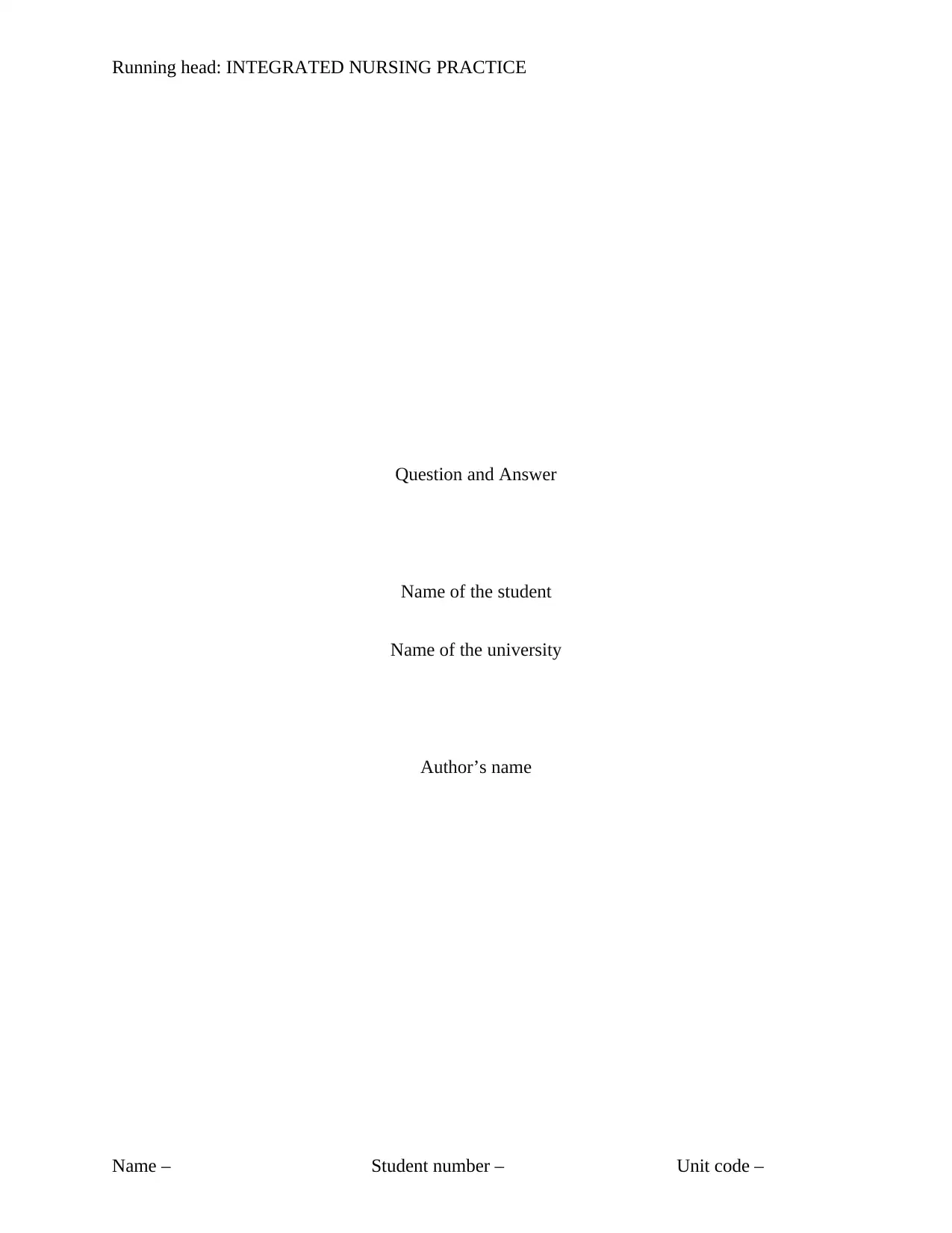
Running head: INTEGRATED NURSING PRACTICE
Question and Answer
Name of the student
Name of the university
Author’s name
Name – Student number – Unit code –
Question and Answer
Name of the student
Name of the university
Author’s name
Name – Student number – Unit code –
Paraphrase This Document
Need a fresh take? Get an instant paraphrase of this document with our AI Paraphraser
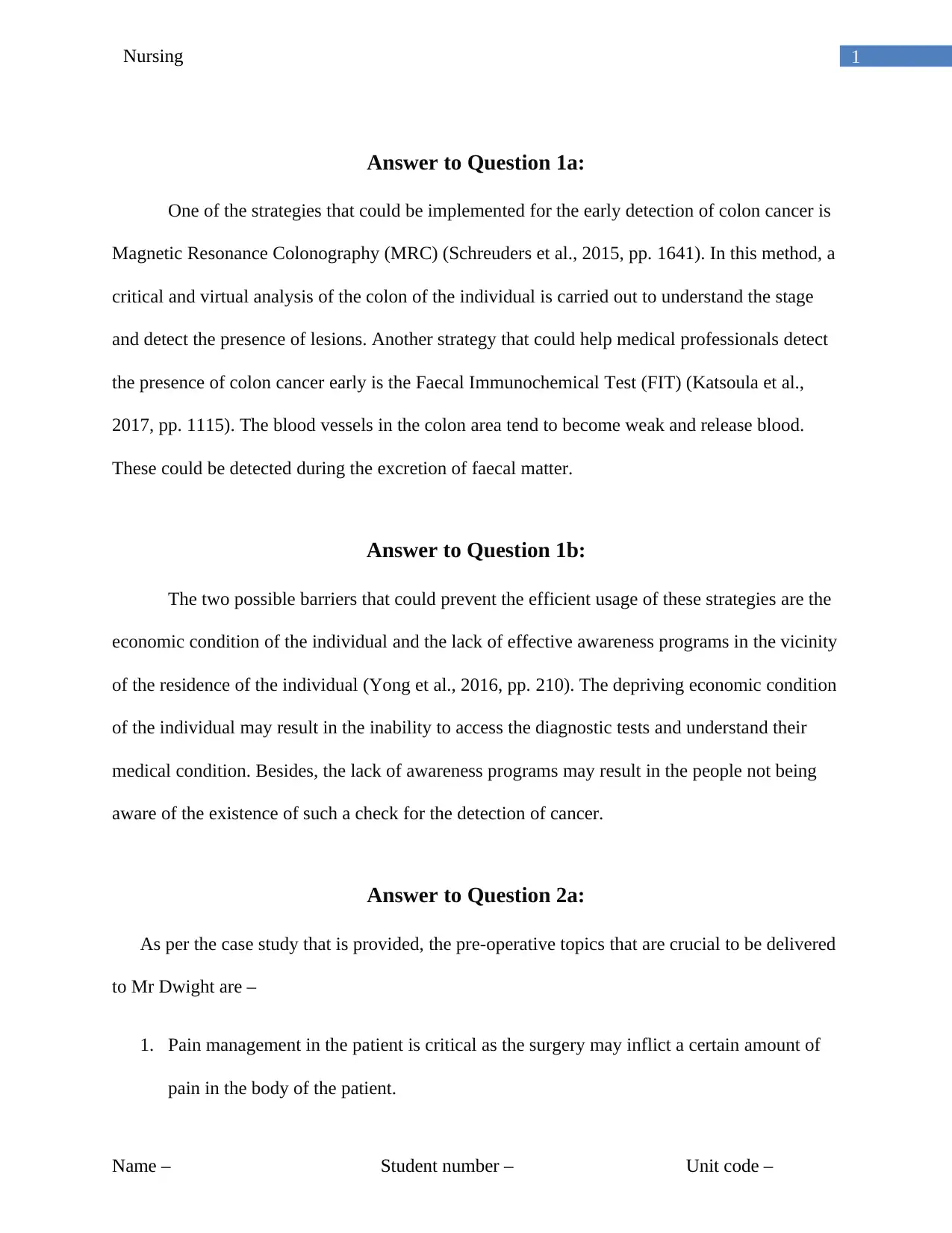
1Nursing
Answer to Question 1a:
One of the strategies that could be implemented for the early detection of colon cancer is
Magnetic Resonance Colonography (MRC) (Schreuders et al., 2015, pp. 1641). In this method, a
critical and virtual analysis of the colon of the individual is carried out to understand the stage
and detect the presence of lesions. Another strategy that could help medical professionals detect
the presence of colon cancer early is the Faecal Immunochemical Test (FIT) (Katsoula et al.,
2017, pp. 1115). The blood vessels in the colon area tend to become weak and release blood.
These could be detected during the excretion of faecal matter.
Answer to Question 1b:
The two possible barriers that could prevent the efficient usage of these strategies are the
economic condition of the individual and the lack of effective awareness programs in the vicinity
of the residence of the individual (Yong et al., 2016, pp. 210). The depriving economic condition
of the individual may result in the inability to access the diagnostic tests and understand their
medical condition. Besides, the lack of awareness programs may result in the people not being
aware of the existence of such a check for the detection of cancer.
Answer to Question 2a:
As per the case study that is provided, the pre-operative topics that are crucial to be delivered
to Mr Dwight are –
1. Pain management in the patient is critical as the surgery may inflict a certain amount of
pain in the body of the patient.
Name – Student number – Unit code –
Answer to Question 1a:
One of the strategies that could be implemented for the early detection of colon cancer is
Magnetic Resonance Colonography (MRC) (Schreuders et al., 2015, pp. 1641). In this method, a
critical and virtual analysis of the colon of the individual is carried out to understand the stage
and detect the presence of lesions. Another strategy that could help medical professionals detect
the presence of colon cancer early is the Faecal Immunochemical Test (FIT) (Katsoula et al.,
2017, pp. 1115). The blood vessels in the colon area tend to become weak and release blood.
These could be detected during the excretion of faecal matter.
Answer to Question 1b:
The two possible barriers that could prevent the efficient usage of these strategies are the
economic condition of the individual and the lack of effective awareness programs in the vicinity
of the residence of the individual (Yong et al., 2016, pp. 210). The depriving economic condition
of the individual may result in the inability to access the diagnostic tests and understand their
medical condition. Besides, the lack of awareness programs may result in the people not being
aware of the existence of such a check for the detection of cancer.
Answer to Question 2a:
As per the case study that is provided, the pre-operative topics that are crucial to be delivered
to Mr Dwight are –
1. Pain management in the patient is critical as the surgery may inflict a certain amount of
pain in the body of the patient.
Name – Student number – Unit code –
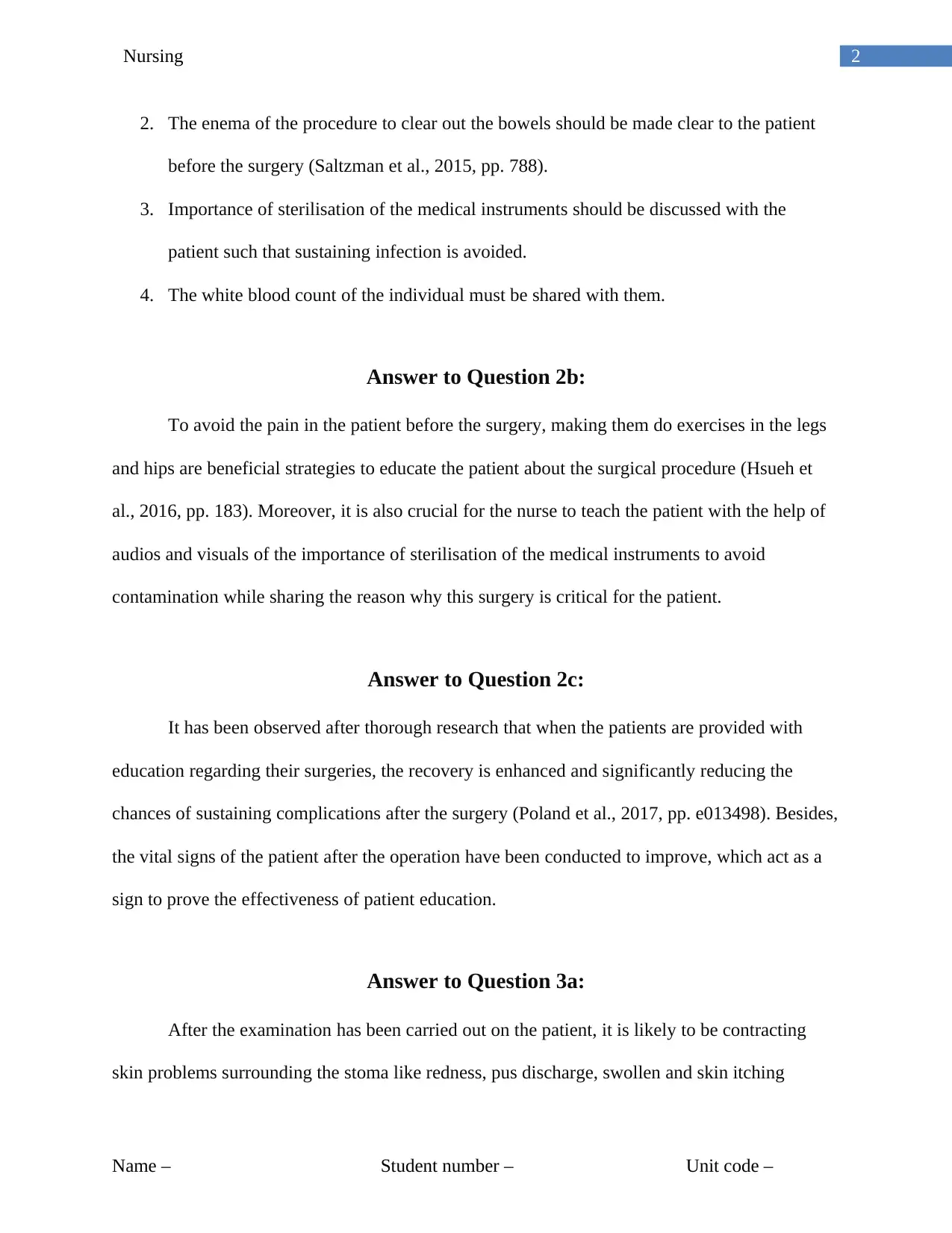
2Nursing
2. The enema of the procedure to clear out the bowels should be made clear to the patient
before the surgery (Saltzman et al., 2015, pp. 788).
3. Importance of sterilisation of the medical instruments should be discussed with the
patient such that sustaining infection is avoided.
4. The white blood count of the individual must be shared with them.
Answer to Question 2b:
To avoid the pain in the patient before the surgery, making them do exercises in the legs
and hips are beneficial strategies to educate the patient about the surgical procedure (Hsueh et
al., 2016, pp. 183). Moreover, it is also crucial for the nurse to teach the patient with the help of
audios and visuals of the importance of sterilisation of the medical instruments to avoid
contamination while sharing the reason why this surgery is critical for the patient.
Answer to Question 2c:
It has been observed after thorough research that when the patients are provided with
education regarding their surgeries, the recovery is enhanced and significantly reducing the
chances of sustaining complications after the surgery (Poland et al., 2017, pp. e013498). Besides,
the vital signs of the patient after the operation have been conducted to improve, which act as a
sign to prove the effectiveness of patient education.
Answer to Question 3a:
After the examination has been carried out on the patient, it is likely to be contracting
skin problems surrounding the stoma like redness, pus discharge, swollen and skin itching
Name – Student number – Unit code –
2. The enema of the procedure to clear out the bowels should be made clear to the patient
before the surgery (Saltzman et al., 2015, pp. 788).
3. Importance of sterilisation of the medical instruments should be discussed with the
patient such that sustaining infection is avoided.
4. The white blood count of the individual must be shared with them.
Answer to Question 2b:
To avoid the pain in the patient before the surgery, making them do exercises in the legs
and hips are beneficial strategies to educate the patient about the surgical procedure (Hsueh et
al., 2016, pp. 183). Moreover, it is also crucial for the nurse to teach the patient with the help of
audios and visuals of the importance of sterilisation of the medical instruments to avoid
contamination while sharing the reason why this surgery is critical for the patient.
Answer to Question 2c:
It has been observed after thorough research that when the patients are provided with
education regarding their surgeries, the recovery is enhanced and significantly reducing the
chances of sustaining complications after the surgery (Poland et al., 2017, pp. e013498). Besides,
the vital signs of the patient after the operation have been conducted to improve, which act as a
sign to prove the effectiveness of patient education.
Answer to Question 3a:
After the examination has been carried out on the patient, it is likely to be contracting
skin problems surrounding the stoma like redness, pus discharge, swollen and skin itching
Name – Student number – Unit code –
⊘ This is a preview!⊘
Do you want full access?
Subscribe today to unlock all pages.

Trusted by 1+ million students worldwide
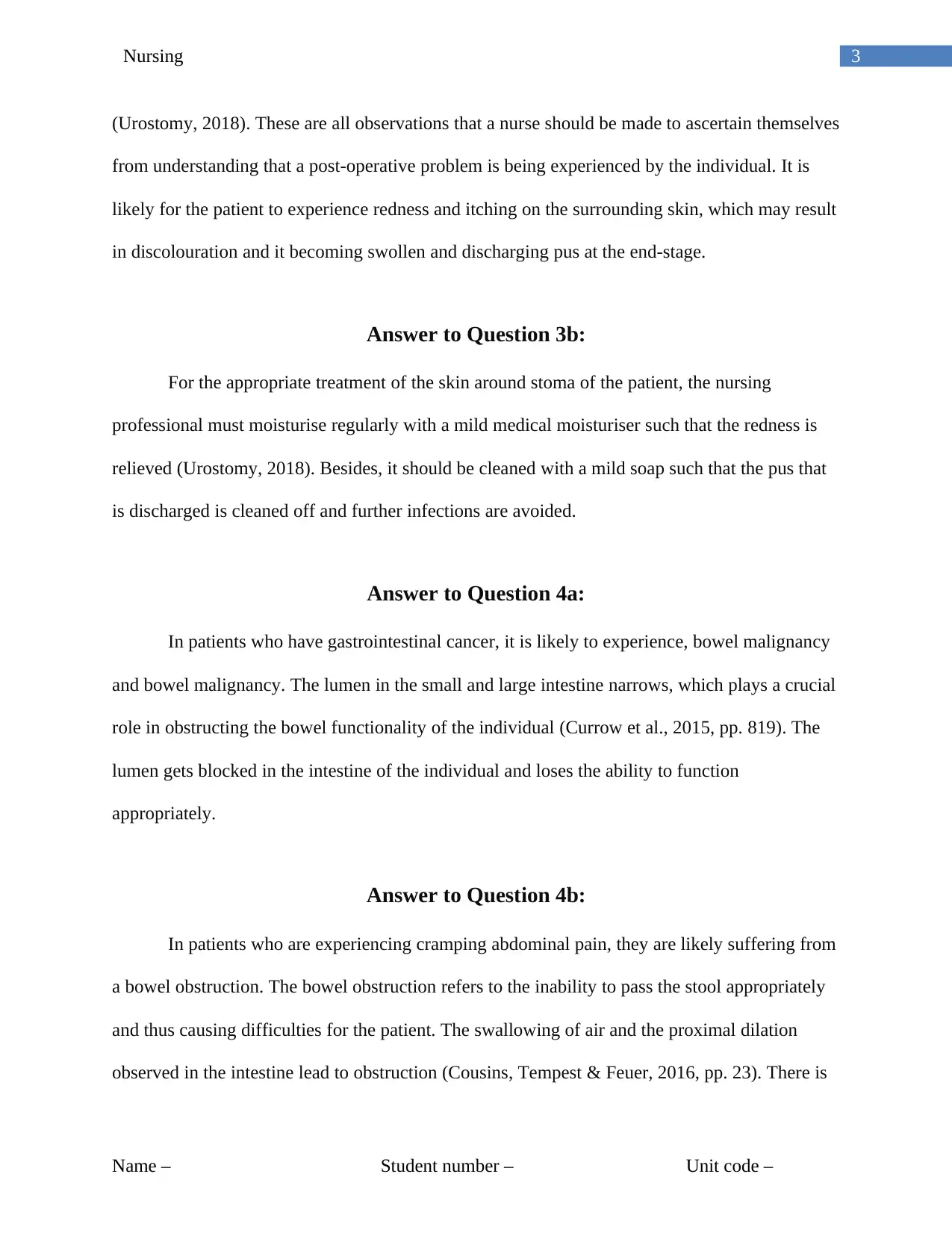
3Nursing
(Urostomy, 2018). These are all observations that a nurse should be made to ascertain themselves
from understanding that a post-operative problem is being experienced by the individual. It is
likely for the patient to experience redness and itching on the surrounding skin, which may result
in discolouration and it becoming swollen and discharging pus at the end-stage.
Answer to Question 3b:
For the appropriate treatment of the skin around stoma of the patient, the nursing
professional must moisturise regularly with a mild medical moisturiser such that the redness is
relieved (Urostomy, 2018). Besides, it should be cleaned with a mild soap such that the pus that
is discharged is cleaned off and further infections are avoided.
Answer to Question 4a:
In patients who have gastrointestinal cancer, it is likely to experience, bowel malignancy
and bowel malignancy. The lumen in the small and large intestine narrows, which plays a crucial
role in obstructing the bowel functionality of the individual (Currow et al., 2015, pp. 819). The
lumen gets blocked in the intestine of the individual and loses the ability to function
appropriately.
Answer to Question 4b:
In patients who are experiencing cramping abdominal pain, they are likely suffering from
a bowel obstruction. The bowel obstruction refers to the inability to pass the stool appropriately
and thus causing difficulties for the patient. The swallowing of air and the proximal dilation
observed in the intestine lead to obstruction (Cousins, Tempest & Feuer, 2016, pp. 23). There is
Name – Student number – Unit code –
(Urostomy, 2018). These are all observations that a nurse should be made to ascertain themselves
from understanding that a post-operative problem is being experienced by the individual. It is
likely for the patient to experience redness and itching on the surrounding skin, which may result
in discolouration and it becoming swollen and discharging pus at the end-stage.
Answer to Question 3b:
For the appropriate treatment of the skin around stoma of the patient, the nursing
professional must moisturise regularly with a mild medical moisturiser such that the redness is
relieved (Urostomy, 2018). Besides, it should be cleaned with a mild soap such that the pus that
is discharged is cleaned off and further infections are avoided.
Answer to Question 4a:
In patients who have gastrointestinal cancer, it is likely to experience, bowel malignancy
and bowel malignancy. The lumen in the small and large intestine narrows, which plays a crucial
role in obstructing the bowel functionality of the individual (Currow et al., 2015, pp. 819). The
lumen gets blocked in the intestine of the individual and loses the ability to function
appropriately.
Answer to Question 4b:
In patients who are experiencing cramping abdominal pain, they are likely suffering from
a bowel obstruction. The bowel obstruction refers to the inability to pass the stool appropriately
and thus causing difficulties for the patient. The swallowing of air and the proximal dilation
observed in the intestine lead to obstruction (Cousins, Tempest & Feuer, 2016, pp. 23). There is
Name – Student number – Unit code –
Paraphrase This Document
Need a fresh take? Get an instant paraphrase of this document with our AI Paraphraser

4Nursing
a high chance of vomiting if the blockage is detected to be proximal. The third spacing of fluid in
the intestinal lumen causes massive dehydration and weakness for the patient. It makes them
unable to carry out daily activities and makes them lie on the bed all day.
Answer to Question 5a:
The adverse effects of blood transfusion that could be observed in the case of Mr Dwight
are – bronchospasm, bacterial contamination, hypothermia and iron accumulation.
Bronchospasm may be found in individuals with colon cancer who have been transfused with
foreign plasma proteins to counter-attack on the growth of the cancer cells. The contaminants
from the skin of the donor and the usage of unsterilized instruments like syringes may pose as a
threat for causing bacterial contamination for the recipient (Schiergens et al., 2015, pp. 77).
Rapid infusion of blood transfers causes the recipient to experience hypothermia with an
increased accumulation of iron which can influence the functionality of the liver (Poveda &
Nascimento, 2017, pp. e12688).
Answer to Question 5b:
The nursing actions are as follows:
1. As a registered nurse, it is their responsibility to stop the further transfusion of blood while
also supporting the airway of the patient for efficient circulation.
2. Separate the infusion set and supplants it with new I.V. tubing and hydrate the patient with
0.9% sodium chloride solution and quickly tell the senior medicinal services specialist for
orders according to the standard 7.3 and 7.4 of the NSQHS to undertake safety measures
(NSQHS Standards, 2015).
Name – Student number – Unit code –
a high chance of vomiting if the blockage is detected to be proximal. The third spacing of fluid in
the intestinal lumen causes massive dehydration and weakness for the patient. It makes them
unable to carry out daily activities and makes them lie on the bed all day.
Answer to Question 5a:
The adverse effects of blood transfusion that could be observed in the case of Mr Dwight
are – bronchospasm, bacterial contamination, hypothermia and iron accumulation.
Bronchospasm may be found in individuals with colon cancer who have been transfused with
foreign plasma proteins to counter-attack on the growth of the cancer cells. The contaminants
from the skin of the donor and the usage of unsterilized instruments like syringes may pose as a
threat for causing bacterial contamination for the recipient (Schiergens et al., 2015, pp. 77).
Rapid infusion of blood transfers causes the recipient to experience hypothermia with an
increased accumulation of iron which can influence the functionality of the liver (Poveda &
Nascimento, 2017, pp. e12688).
Answer to Question 5b:
The nursing actions are as follows:
1. As a registered nurse, it is their responsibility to stop the further transfusion of blood while
also supporting the airway of the patient for efficient circulation.
2. Separate the infusion set and supplants it with new I.V. tubing and hydrate the patient with
0.9% sodium chloride solution and quickly tell the senior medicinal services specialist for
orders according to the standard 7.3 and 7.4 of the NSQHS to undertake safety measures
(NSQHS Standards, 2015).
Name – Student number – Unit code –
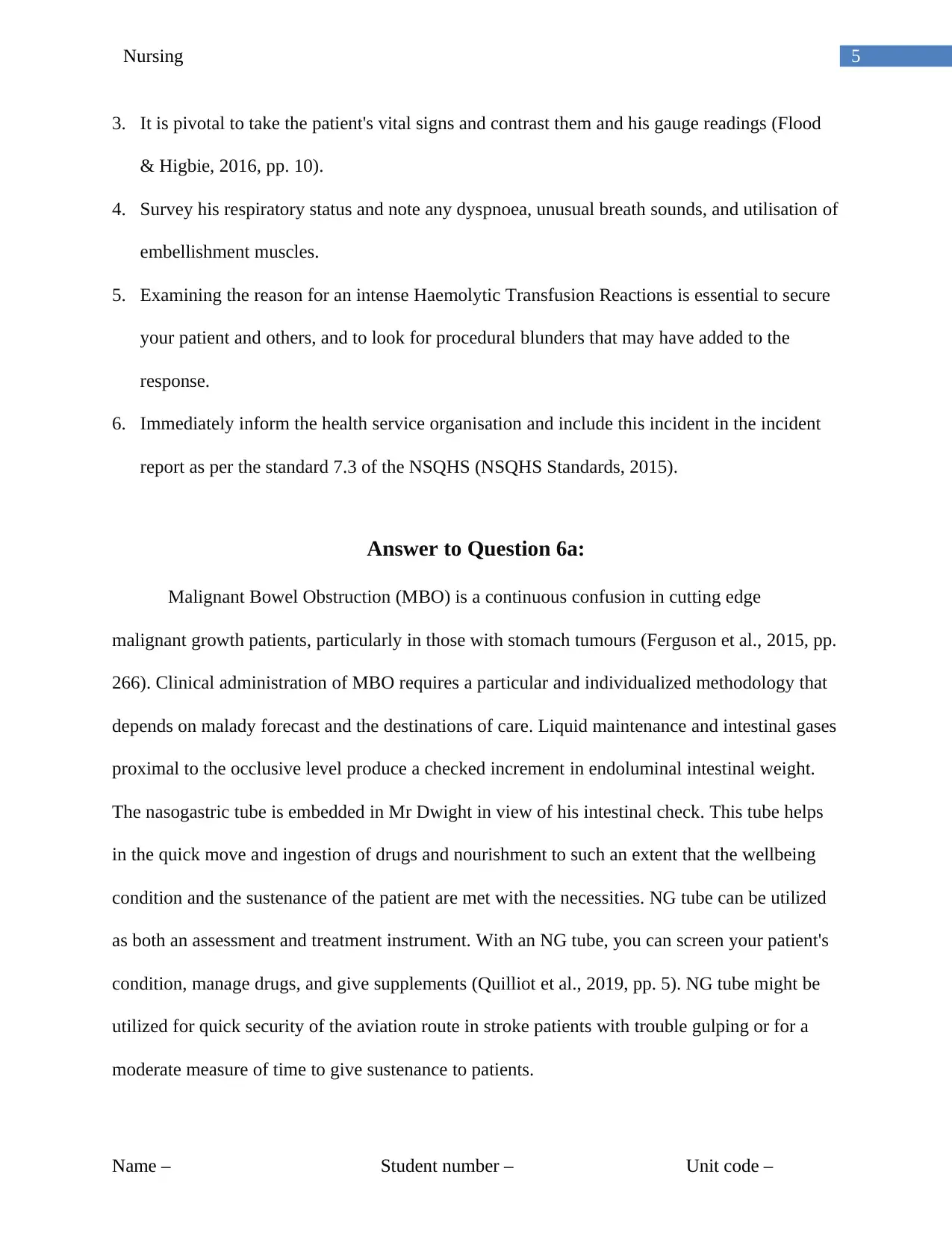
5Nursing
3. It is pivotal to take the patient's vital signs and contrast them and his gauge readings (Flood
& Higbie, 2016, pp. 10).
4. Survey his respiratory status and note any dyspnoea, unusual breath sounds, and utilisation of
embellishment muscles.
5. Examining the reason for an intense Haemolytic Transfusion Reactions is essential to secure
your patient and others, and to look for procedural blunders that may have added to the
response.
6. Immediately inform the health service organisation and include this incident in the incident
report as per the standard 7.3 of the NSQHS (NSQHS Standards, 2015).
Answer to Question 6a:
Malignant Bowel Obstruction (MBO) is a continuous confusion in cutting edge
malignant growth patients, particularly in those with stomach tumours (Ferguson et al., 2015, pp.
266). Clinical administration of MBO requires a particular and individualized methodology that
depends on malady forecast and the destinations of care. Liquid maintenance and intestinal gases
proximal to the occlusive level produce a checked increment in endoluminal intestinal weight.
The nasogastric tube is embedded in Mr Dwight in view of his intestinal check. This tube helps
in the quick move and ingestion of drugs and nourishment to such an extent that the wellbeing
condition and the sustenance of the patient are met with the necessities. NG tube can be utilized
as both an assessment and treatment instrument. With an NG tube, you can screen your patient's
condition, manage drugs, and give supplements (Quilliot et al., 2019, pp. 5). NG tube might be
utilized for quick security of the aviation route in stroke patients with trouble gulping or for a
moderate measure of time to give sustenance to patients.
Name – Student number – Unit code –
3. It is pivotal to take the patient's vital signs and contrast them and his gauge readings (Flood
& Higbie, 2016, pp. 10).
4. Survey his respiratory status and note any dyspnoea, unusual breath sounds, and utilisation of
embellishment muscles.
5. Examining the reason for an intense Haemolytic Transfusion Reactions is essential to secure
your patient and others, and to look for procedural blunders that may have added to the
response.
6. Immediately inform the health service organisation and include this incident in the incident
report as per the standard 7.3 of the NSQHS (NSQHS Standards, 2015).
Answer to Question 6a:
Malignant Bowel Obstruction (MBO) is a continuous confusion in cutting edge
malignant growth patients, particularly in those with stomach tumours (Ferguson et al., 2015, pp.
266). Clinical administration of MBO requires a particular and individualized methodology that
depends on malady forecast and the destinations of care. Liquid maintenance and intestinal gases
proximal to the occlusive level produce a checked increment in endoluminal intestinal weight.
The nasogastric tube is embedded in Mr Dwight in view of his intestinal check. This tube helps
in the quick move and ingestion of drugs and nourishment to such an extent that the wellbeing
condition and the sustenance of the patient are met with the necessities. NG tube can be utilized
as both an assessment and treatment instrument. With an NG tube, you can screen your patient's
condition, manage drugs, and give supplements (Quilliot et al., 2019, pp. 5). NG tube might be
utilized for quick security of the aviation route in stroke patients with trouble gulping or for a
moderate measure of time to give sustenance to patients.
Name – Student number – Unit code –
⊘ This is a preview!⊘
Do you want full access?
Subscribe today to unlock all pages.

Trusted by 1+ million students worldwide

6Nursing
Answer to Question 6b:
Nasogastric tube arrangement is essential to patients for various reasons. One explanation
is that the tube can discharge fluid and air substance from the stomach of the patients. Those
experiencing gastric or intestinal hindrance must have their NG tubes set accurately to keep the
patient from reaching the substance of the stomach. The NG tubes enable to obtain the gastric
substances and introduce a passage into the GI tract (Bakker et al., 2015, pp. 1133).
The Nasogastric Tube that is to be administered to Mr. Dwight, requires an appropriate
assessment of its placement. The registered nurse can ask the patient to hum or talk or use an
irrigation syringe to aspirate the tube and measure the pH level of the gastric contents (Richards
& Pravikoff, 2016). Moreover, the nursing professional may also instill 30 cc of air bolus into
the epigastrium of the patient by placing a stethoscope to make a whooshing sound.
Answer to Question 7:
The clinical problems that could occur during his admission to the palliative care unit in
accordance with the nutrition and fluid are:
1. Mr Dwight has been refusing to eat or drink anything for which there is a high chance that he
may feel dehydrated because of loss of nutrients and their imbalances.
2. The other clinical problem that he may experience is a sudden drop in the body weight and
feeling mal-nourished. He may feel weak and like to stay in bed all day which can have
detrimental effects on his health.
Name – Student number – Unit code –
Answer to Question 6b:
Nasogastric tube arrangement is essential to patients for various reasons. One explanation
is that the tube can discharge fluid and air substance from the stomach of the patients. Those
experiencing gastric or intestinal hindrance must have their NG tubes set accurately to keep the
patient from reaching the substance of the stomach. The NG tubes enable to obtain the gastric
substances and introduce a passage into the GI tract (Bakker et al., 2015, pp. 1133).
The Nasogastric Tube that is to be administered to Mr. Dwight, requires an appropriate
assessment of its placement. The registered nurse can ask the patient to hum or talk or use an
irrigation syringe to aspirate the tube and measure the pH level of the gastric contents (Richards
& Pravikoff, 2016). Moreover, the nursing professional may also instill 30 cc of air bolus into
the epigastrium of the patient by placing a stethoscope to make a whooshing sound.
Answer to Question 7:
The clinical problems that could occur during his admission to the palliative care unit in
accordance with the nutrition and fluid are:
1. Mr Dwight has been refusing to eat or drink anything for which there is a high chance that he
may feel dehydrated because of loss of nutrients and their imbalances.
2. The other clinical problem that he may experience is a sudden drop in the body weight and
feeling mal-nourished. He may feel weak and like to stay in bed all day which can have
detrimental effects on his health.
Name – Student number – Unit code –
Paraphrase This Document
Need a fresh take? Get an instant paraphrase of this document with our AI Paraphraser
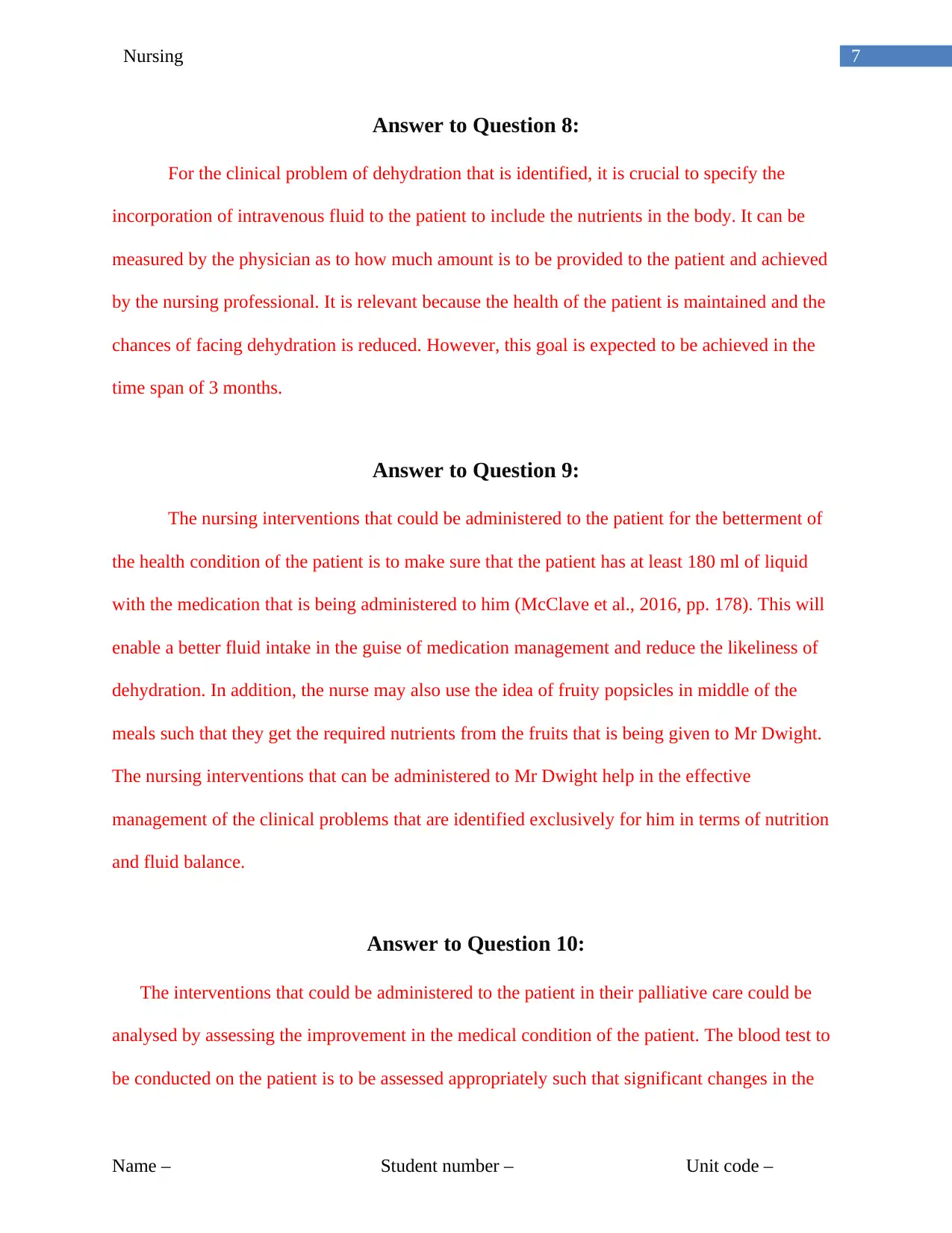
7Nursing
Answer to Question 8:
For the clinical problem of dehydration that is identified, it is crucial to specify the
incorporation of intravenous fluid to the patient to include the nutrients in the body. It can be
measured by the physician as to how much amount is to be provided to the patient and achieved
by the nursing professional. It is relevant because the health of the patient is maintained and the
chances of facing dehydration is reduced. However, this goal is expected to be achieved in the
time span of 3 months.
Answer to Question 9:
The nursing interventions that could be administered to the patient for the betterment of
the health condition of the patient is to make sure that the patient has at least 180 ml of liquid
with the medication that is being administered to him (McClave et al., 2016, pp. 178). This will
enable a better fluid intake in the guise of medication management and reduce the likeliness of
dehydration. In addition, the nurse may also use the idea of fruity popsicles in middle of the
meals such that they get the required nutrients from the fruits that is being given to Mr Dwight.
The nursing interventions that can be administered to Mr Dwight help in the effective
management of the clinical problems that are identified exclusively for him in terms of nutrition
and fluid balance.
Answer to Question 10:
The interventions that could be administered to the patient in their palliative care could be
analysed by assessing the improvement in the medical condition of the patient. The blood test to
be conducted on the patient is to be assessed appropriately such that significant changes in the
Name – Student number – Unit code –
Answer to Question 8:
For the clinical problem of dehydration that is identified, it is crucial to specify the
incorporation of intravenous fluid to the patient to include the nutrients in the body. It can be
measured by the physician as to how much amount is to be provided to the patient and achieved
by the nursing professional. It is relevant because the health of the patient is maintained and the
chances of facing dehydration is reduced. However, this goal is expected to be achieved in the
time span of 3 months.
Answer to Question 9:
The nursing interventions that could be administered to the patient for the betterment of
the health condition of the patient is to make sure that the patient has at least 180 ml of liquid
with the medication that is being administered to him (McClave et al., 2016, pp. 178). This will
enable a better fluid intake in the guise of medication management and reduce the likeliness of
dehydration. In addition, the nurse may also use the idea of fruity popsicles in middle of the
meals such that they get the required nutrients from the fruits that is being given to Mr Dwight.
The nursing interventions that can be administered to Mr Dwight help in the effective
management of the clinical problems that are identified exclusively for him in terms of nutrition
and fluid balance.
Answer to Question 10:
The interventions that could be administered to the patient in their palliative care could be
analysed by assessing the improvement in the medical condition of the patient. The blood test to
be conducted on the patient is to be assessed appropriately such that significant changes in the
Name – Student number – Unit code –
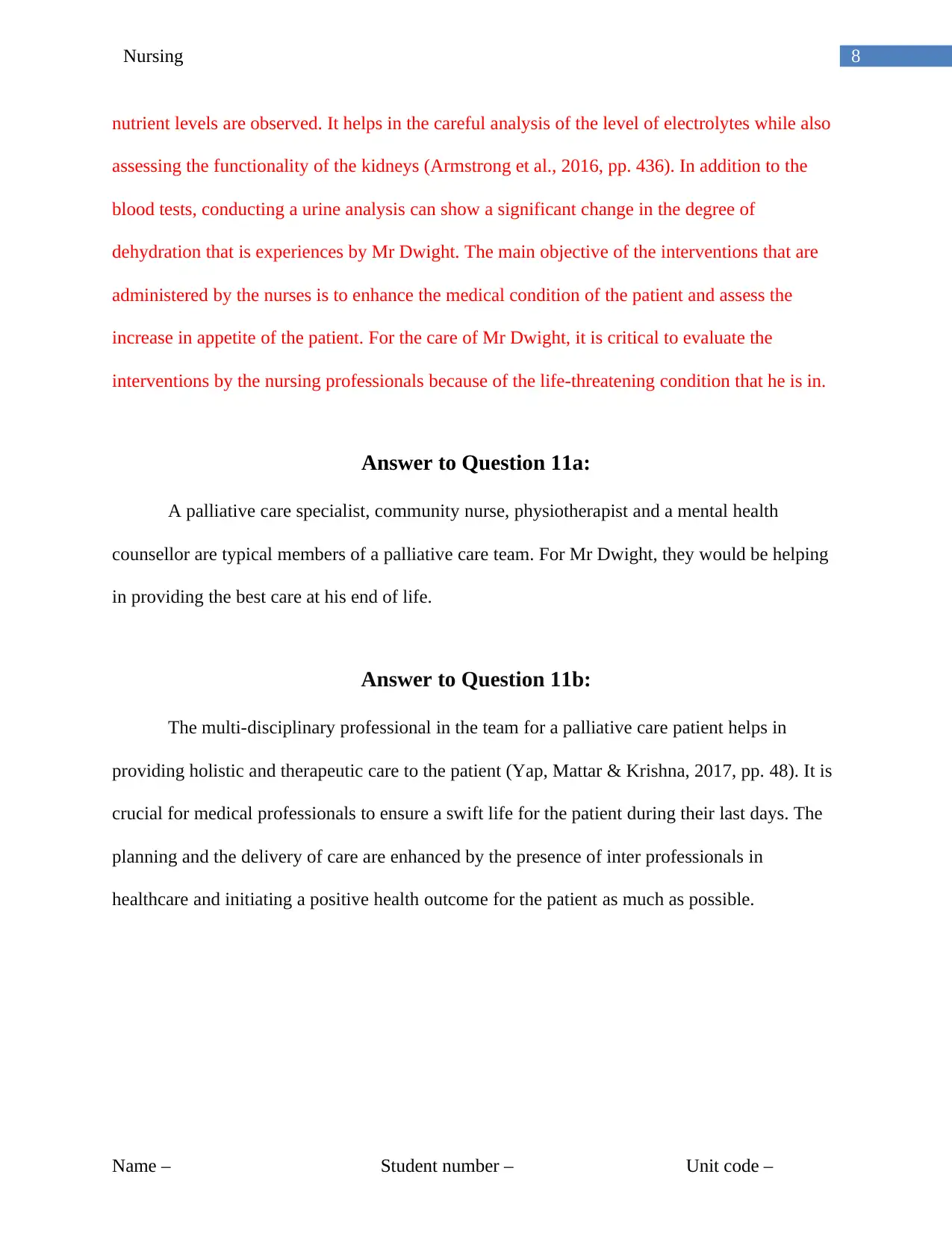
8Nursing
nutrient levels are observed. It helps in the careful analysis of the level of electrolytes while also
assessing the functionality of the kidneys (Armstrong et al., 2016, pp. 436). In addition to the
blood tests, conducting a urine analysis can show a significant change in the degree of
dehydration that is experiences by Mr Dwight. The main objective of the interventions that are
administered by the nurses is to enhance the medical condition of the patient and assess the
increase in appetite of the patient. For the care of Mr Dwight, it is critical to evaluate the
interventions by the nursing professionals because of the life-threatening condition that he is in.
Answer to Question 11a:
A palliative care specialist, community nurse, physiotherapist and a mental health
counsellor are typical members of a palliative care team. For Mr Dwight, they would be helping
in providing the best care at his end of life.
Answer to Question 11b:
The multi-disciplinary professional in the team for a palliative care patient helps in
providing holistic and therapeutic care to the patient (Yap, Mattar & Krishna, 2017, pp. 48). It is
crucial for medical professionals to ensure a swift life for the patient during their last days. The
planning and the delivery of care are enhanced by the presence of inter professionals in
healthcare and initiating a positive health outcome for the patient as much as possible.
Name – Student number – Unit code –
nutrient levels are observed. It helps in the careful analysis of the level of electrolytes while also
assessing the functionality of the kidneys (Armstrong et al., 2016, pp. 436). In addition to the
blood tests, conducting a urine analysis can show a significant change in the degree of
dehydration that is experiences by Mr Dwight. The main objective of the interventions that are
administered by the nurses is to enhance the medical condition of the patient and assess the
increase in appetite of the patient. For the care of Mr Dwight, it is critical to evaluate the
interventions by the nursing professionals because of the life-threatening condition that he is in.
Answer to Question 11a:
A palliative care specialist, community nurse, physiotherapist and a mental health
counsellor are typical members of a palliative care team. For Mr Dwight, they would be helping
in providing the best care at his end of life.
Answer to Question 11b:
The multi-disciplinary professional in the team for a palliative care patient helps in
providing holistic and therapeutic care to the patient (Yap, Mattar & Krishna, 2017, pp. 48). It is
crucial for medical professionals to ensure a swift life for the patient during their last days. The
planning and the delivery of care are enhanced by the presence of inter professionals in
healthcare and initiating a positive health outcome for the patient as much as possible.
Name – Student number – Unit code –
⊘ This is a preview!⊘
Do you want full access?
Subscribe today to unlock all pages.

Trusted by 1+ million students worldwide

9Nursing
References
Armstrong, L. E., Kavouras, S. A., Walsh, N. P., & Roberts, W. O. (2016). Diagnosing
dehydration? Blend evidence with clinical observations. Current opinion in clinical
nutrition and metabolic care, 19(6), 434-438.
Bakker, N., Cakir, H., Doodeman, H. J., & Houdijk, A. P. J. (2015). Eight years of experience
with enhanced recovery after surgery in patients with colon cancer: impact of measures to
improve adherence. Surgery, 157(6), 1130-1136.
Cousins, S. E., Tempest, E., & Feuer, D. J. (2016). Surgery for the resolution of symptoms in
malignant bowel obstruction in advanced gynaecological and gastrointestinal
cancer. Cochrane Database of Systematic Reviews, (1), 1-75.
Currow, D. C., Quinn, S., Agar, M., Fazekas, B., Hardy, J., McCaffrey, N., ...& Clark, K. (2015).
Double-blind, placebo-controlled, randomized trial of octreotide in malignant bowel
obstruction. Journal of Pain and symptom management, 49(5), 814-821.
Ferguson, H. J. M., Ferguson, C. I., Speakman, J., & Ismail, T. (2015). Management of intestinal
obstruction in advanced malignancy. Annals of medicine and surgery, 4(3), 264-270.
Flood, L. S., & Higbie, J. (2016). A comparative assessment of nursing students' cognitive
knowledge of blood transfusion using lecture and simulation. Nurse education in
practice, 16(1), 8-13.
Hsueh, F. C., Chen, C. M., Sun, C. A., Chou, Y. C., Hsiao, S. M., & Yang, T. (2016). A study on
the effects of a health education intervention on anxiety and pain during colonoscopy
procedures. Journal of Nursing Research, 24(2), 181-189.
Name – Student number – Unit code –
References
Armstrong, L. E., Kavouras, S. A., Walsh, N. P., & Roberts, W. O. (2016). Diagnosing
dehydration? Blend evidence with clinical observations. Current opinion in clinical
nutrition and metabolic care, 19(6), 434-438.
Bakker, N., Cakir, H., Doodeman, H. J., & Houdijk, A. P. J. (2015). Eight years of experience
with enhanced recovery after surgery in patients with colon cancer: impact of measures to
improve adherence. Surgery, 157(6), 1130-1136.
Cousins, S. E., Tempest, E., & Feuer, D. J. (2016). Surgery for the resolution of symptoms in
malignant bowel obstruction in advanced gynaecological and gastrointestinal
cancer. Cochrane Database of Systematic Reviews, (1), 1-75.
Currow, D. C., Quinn, S., Agar, M., Fazekas, B., Hardy, J., McCaffrey, N., ...& Clark, K. (2015).
Double-blind, placebo-controlled, randomized trial of octreotide in malignant bowel
obstruction. Journal of Pain and symptom management, 49(5), 814-821.
Ferguson, H. J. M., Ferguson, C. I., Speakman, J., & Ismail, T. (2015). Management of intestinal
obstruction in advanced malignancy. Annals of medicine and surgery, 4(3), 264-270.
Flood, L. S., & Higbie, J. (2016). A comparative assessment of nursing students' cognitive
knowledge of blood transfusion using lecture and simulation. Nurse education in
practice, 16(1), 8-13.
Hsueh, F. C., Chen, C. M., Sun, C. A., Chou, Y. C., Hsiao, S. M., & Yang, T. (2016). A study on
the effects of a health education intervention on anxiety and pain during colonoscopy
procedures. Journal of Nursing Research, 24(2), 181-189.
Name – Student number – Unit code –
Paraphrase This Document
Need a fresh take? Get an instant paraphrase of this document with our AI Paraphraser

10Nursing
Katsoula, A., Paschos, P., Haidich, A. B., Tsapas, A., & Giouleme, O. (2017). Diagnostic
accuracy of the fecal immunochemical test in patients at increased risk for colorectal
cancer: a meta-analysis. JAMA internal medicine, 177(8), 1110-1118.
McClave, S. A., Taylor, B. E., Martindale, R. G., Warren, M. M., Johnson, D. R., Braunschweig,
C., ... & Gervasio, J. M. (2016). Guidelines for the provision and assessment of nutrition
support therapy in the adult critically ill patient: Society of Critical Care Medicine
(SCCM) and American Society for Parenteral and Enteral Nutrition (ASPEN). Journal of
Parenteral and Enteral Nutrition, 40(2), 159-211.
NSQHS Standards. (2015). Retrieved 30 December 2019, from
https://www.safetyandquality.gov.au/sites/default/files/migrated/NSQHS-Standards-
Sept2011.pdf
Poland, F., Spalding, N., Gregory, S., McCulloch, J., Sargen, K., & Vicary, P.
(2017). Developing patient education to enhance recovery after colorectal surgery
through action research: a qualitative study. BMJ Open, 7(6), e013498.
Poveda, V. D. B., & Nascimento, A. D. S. (2017). The effect of intraoperative hypothermia upon
blood transfusion needs and length of stay among gastrointestinal system cancer
surgery. European journal of cancer care, 26(6), e12688.
Quilliot, D., Michot, N., Germain, L., Krier, J., Lopez, A., Bresler, L., ... & Nguyen-Thi, P. L.
(2019). Feasibility, acceptability of enteral tube feeding and self-insertion of a
nasogastric tube in the nutritional management of digestive cancers, impact on quality of
life. Clinical Nutrition, 1-8.
Name – Student number – Unit code –
Katsoula, A., Paschos, P., Haidich, A. B., Tsapas, A., & Giouleme, O. (2017). Diagnostic
accuracy of the fecal immunochemical test in patients at increased risk for colorectal
cancer: a meta-analysis. JAMA internal medicine, 177(8), 1110-1118.
McClave, S. A., Taylor, B. E., Martindale, R. G., Warren, M. M., Johnson, D. R., Braunschweig,
C., ... & Gervasio, J. M. (2016). Guidelines for the provision and assessment of nutrition
support therapy in the adult critically ill patient: Society of Critical Care Medicine
(SCCM) and American Society for Parenteral and Enteral Nutrition (ASPEN). Journal of
Parenteral and Enteral Nutrition, 40(2), 159-211.
NSQHS Standards. (2015). Retrieved 30 December 2019, from
https://www.safetyandquality.gov.au/sites/default/files/migrated/NSQHS-Standards-
Sept2011.pdf
Poland, F., Spalding, N., Gregory, S., McCulloch, J., Sargen, K., & Vicary, P.
(2017). Developing patient education to enhance recovery after colorectal surgery
through action research: a qualitative study. BMJ Open, 7(6), e013498.
Poveda, V. D. B., & Nascimento, A. D. S. (2017). The effect of intraoperative hypothermia upon
blood transfusion needs and length of stay among gastrointestinal system cancer
surgery. European journal of cancer care, 26(6), e12688.
Quilliot, D., Michot, N., Germain, L., Krier, J., Lopez, A., Bresler, L., ... & Nguyen-Thi, P. L.
(2019). Feasibility, acceptability of enteral tube feeding and self-insertion of a
nasogastric tube in the nutritional management of digestive cancers, impact on quality of
life. Clinical Nutrition, 1-8.
Name – Student number – Unit code –

11Nursing
Richards, S., & Pravikoff, D. (2016). Feeding Tube Irrigation: Performing.
Saltzman, J. R., Cash, B. D., Pasha, S. F., Early, D. S., Muthusamy, V. R., Khashab, M. A., ... &
Fonkalsrud, L. (2015). Bowel preparation before colonoscopy. Gastrointestinal
endoscopy, 81(4), 781-794.
Schiergens, T. S., Rentsch, M., Kasparek, M. S., Frenes, K., Jauch, K. W., & Thasler, W. E.
(2015). Impact of perioperative allogeneic red blood cell transfusion on recurrence and
overall survival after resection of colorectal liver metastases. Diseases of the Colon &
Rectum, 58(1), 74-82.
Schreuders, E. H., Ruco, A., Rabeneck, L., Schoen, R. E., Sung, J. J., Young, G. P., & Kuipers,
E. J. (2015). Colorectal cancer screening: a global overview of existing
programmes. Gut, 64(10), 1637-1649.
Urostomy. (2018). Retrieved 18 December 2019, from
https://account.allinahealth.org/library/content/60/477
Yap, H. W., Mattar, S. A. M., & Krishna, R. (2017). Mentoring in Occupational therapy and
Physiotherapy, its place in a Palliative Medicine multidisciplinary mentoring
program. Journal of Pediatrics and Palliative Care, 2(1), 46-55.
Yong, S. K., Ong, W. S., Koh, G. C. H., Yeo, R. M. C., & Ha, T. C. (2016). Colorectal cancer
screening: Barriers to the faecal occult blood test (FOBT) and colonoscopy in
Singapore. Proceedings of Singapore Healthcare, 25(4), 207-214.
Name – Student number – Unit code –
Richards, S., & Pravikoff, D. (2016). Feeding Tube Irrigation: Performing.
Saltzman, J. R., Cash, B. D., Pasha, S. F., Early, D. S., Muthusamy, V. R., Khashab, M. A., ... &
Fonkalsrud, L. (2015). Bowel preparation before colonoscopy. Gastrointestinal
endoscopy, 81(4), 781-794.
Schiergens, T. S., Rentsch, M., Kasparek, M. S., Frenes, K., Jauch, K. W., & Thasler, W. E.
(2015). Impact of perioperative allogeneic red blood cell transfusion on recurrence and
overall survival after resection of colorectal liver metastases. Diseases of the Colon &
Rectum, 58(1), 74-82.
Schreuders, E. H., Ruco, A., Rabeneck, L., Schoen, R. E., Sung, J. J., Young, G. P., & Kuipers,
E. J. (2015). Colorectal cancer screening: a global overview of existing
programmes. Gut, 64(10), 1637-1649.
Urostomy. (2018). Retrieved 18 December 2019, from
https://account.allinahealth.org/library/content/60/477
Yap, H. W., Mattar, S. A. M., & Krishna, R. (2017). Mentoring in Occupational therapy and
Physiotherapy, its place in a Palliative Medicine multidisciplinary mentoring
program. Journal of Pediatrics and Palliative Care, 2(1), 46-55.
Yong, S. K., Ong, W. S., Koh, G. C. H., Yeo, R. M. C., & Ha, T. C. (2016). Colorectal cancer
screening: Barriers to the faecal occult blood test (FOBT) and colonoscopy in
Singapore. Proceedings of Singapore Healthcare, 25(4), 207-214.
Name – Student number – Unit code –
⊘ This is a preview!⊘
Do you want full access?
Subscribe today to unlock all pages.

Trusted by 1+ million students worldwide
1 out of 12
Related Documents
Your All-in-One AI-Powered Toolkit for Academic Success.
+13062052269
info@desklib.com
Available 24*7 on WhatsApp / Email
![[object Object]](/_next/static/media/star-bottom.7253800d.svg)
Unlock your academic potential
Copyright © 2020–2025 A2Z Services. All Rights Reserved. Developed and managed by ZUCOL.





